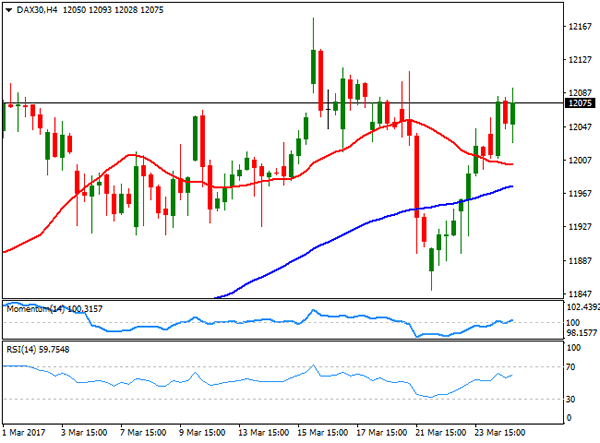EUR/USD
The American dollar closed the week mixed, down against most of its major rivals, but those related to commodities, as speculative interest focused last week in unwinding the so-called "Trump-trade." Equities in the US had their worst week since last September, extending their early week decline on Friday after the US President Trump Obamacare repeal bill was pulled back by Republicans, after failing to gather enough support from the Congress. Trump made a quick statement in the Oval Office afterwards, announcing that his party will probably work on the tax reform now, which partially offset dollar and equities’ decline. The EUR/USD pair closed the week around 1.0800, not far from this year high of 1.0828.
In the data front the week was quite light, with March preliminary Markit PMIs taking center stage. In Europe, estimated for the current month beat expectations and final February figures, indicating that the strong pace of growth in the region seen late 2016 continues to accelerate. According to the official report, the Eurozone economic growth reached a six-year high, with the Composite PMI up to 56.7 from 56.0 in the previous month. On the contrary, the US private sector expanded at its slowest pace for six months in the US, as the Markit Composite PMI came in at 53.2, from 54.1 in February.
From a technical point of view, the EUR/USD pair has been contained by a major mid-term resistance, the 1.0820 level which represents the 50% retracement of the post-US election’s decline, although pullbacks from the area have been quite shallow, which implies a high risk of a bullish breakout. In the daily chart, the Momentum indicator maintains its bullish slope, now within overbought territory, whilst the RSI indicator consolidates around 62, reflecting the latest range-bound trading. In the same chart, the 20 DMA heads north below the current level after crossing above the 100 DMA, all of which supports additional advances, particularly on an upward extension beyond the 1.0820/30 region. Shorter term, the 4 hours chart shows that the price has settled a few pips above a horizontal 20 SMA, whilst technical indicators lack directional strength, also reflecting the latest lack of directional strength rather than suggesting buying exhaustion.
Support levels: 1.0765 1.0730 1.0700
Resistance levels: 1.0830 1.0870 1.0910
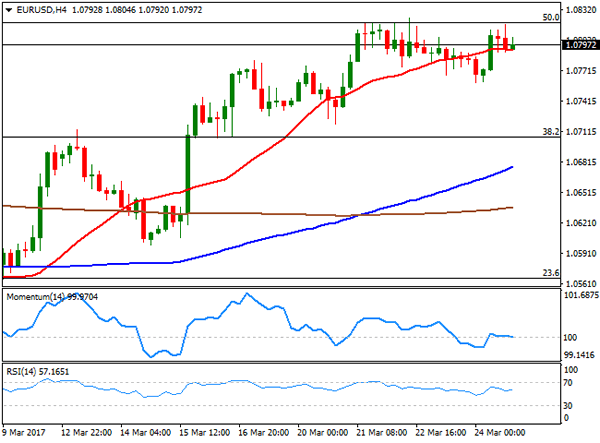
USD/JPY
The USD/JPY pair fell to a fresh yearly low of 110.63 last Friday, undermined by poor US data and news that the US government pulled back from the Congress the healthcare bill, before facing a defeat, as the Republicans were unable to gather enough support. The pair however, bounced some 60 pips, and closed the week in the 111.30 region, as risk aversion eased following Trumps speech in the Oval Office, announcing that they will now focus on the tax reform. Wall Street bounced from its lows after the news, whilst US Treasury yields also recovered some ground, but anyway closed in the red for a second consecutive week. Also weighing on the pair was a tepid advance in US Durable Goods Order in February, and worse-than-expected flash Markit PMIs, showing the slowest pace of expansion in six months. Japan will release its latest inflation figures this upcoming Thursday, alongside with preliminary industrial data for March and employment figures for February. The pair is still at risk of falling further, as in the daily chart, it settled well below its 100 SMA, now flat around 114.50, whilst the Momentum indicator maintains is bearish slope within bearish territory, and the RSI indicator is barely bouncing from oversold readings, now around 33. Furthermore, the pair has met selling interest around 111.60, where the pair bottomed multiple times earlier this year. In the 4 hours chart, technical indicators have bounced from oversold readings, and the Momentum indicator heads north above its mid-line, but the price remains well below its 100 and 200 SMAs, both converging around 113.30/40. The upward corrective movement can extend up to 112.00, a major Fibonacci resistance, without actually affecting the dominant bearish trend. Renewed selling interest below 111.00 should favor a steeper decline towards 109.90, the 50% retracement of late 2016 monthly rally.
Support levels: 111.00 110.70 110.30
Resistance levels: 111.60 112.00 120.45
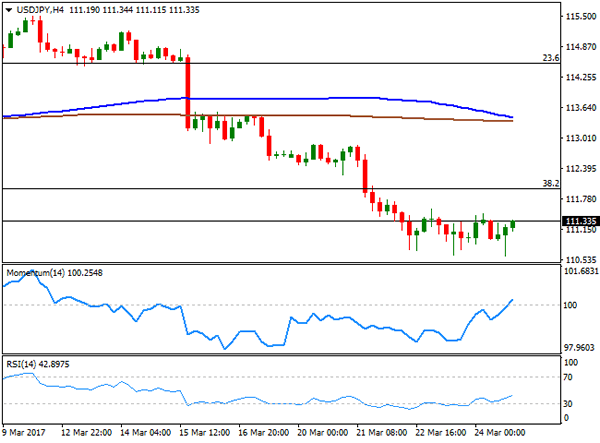
GBP/USD
The GBP/USD pair fell on Friday, but advanced for a second week in-a-row, settling at 1.2470. The Pound got a boost last Tuesday, following the release of higher-than-expected UK inflation figures, exacerbated by broad dollar’s weakness ever since the week started. Nevertheless the pair was unable to advance to retake the 1.2500 level, despite multiple intraday attempts to break higher. Attention this week will center in PM May’s announcement of the beginning of Brexit, as the UK government will trigger the art. 50 of the Lisbon treaty this Wednesday. News released over the weekend showed that the Labour Party will announce its conditions for backing any deal with the EU this Monday, anticipating that they would only support a deal that has the ‘exact same benefits’ as the single market, raising the bar for May’s negotiations. Still early to speculate on the outcome, the UK will indeed face a rough couple of years from now on. The pair topped this past week at 1.2530, 10 pips shy of the 23.6% retracement of the January’s rally, and the daily chart shows that technical indicators have lost their upward strength, but remain near overbought territory, whilst the price is well above a modestly bullish 20 SMA, indicating that the pair may extend its bearish move, particularly if the mentioned 1.2530/40 region continues to cap the upside. In the 4 hours chart, the price broke below its 20 SMA for the first time since mid March, while technical indicators have turned south, currently around their mid-lines, supporting a downward extension. 1.2425 is the 38.2% retracement of the mentioned rally, and a break below it will likely result in a steeper decline towards 1.2330/50.
Support levels: 1.2425 1.2380 1.2340
Resistance levels: 1.2500 1.2540 1.2585
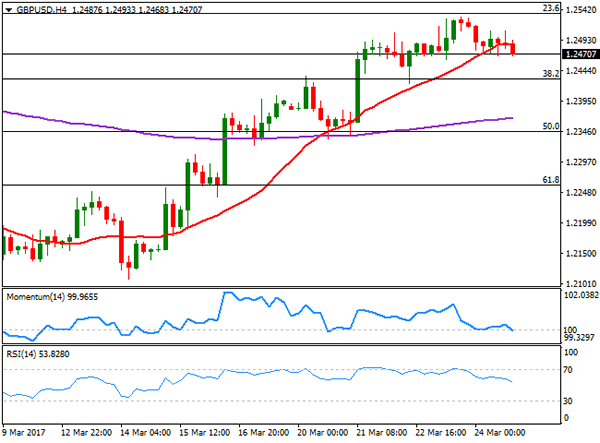
GOLD
Spot gold closed the week with gains at $1,243.59 a troy ounce, marginally lower on Friday, despite dollar and stocks’ decline. The bright metal trimmed its intraday gains on the last day of the week, following the late bounce in US stocks, and after failing to advance beyond its weekly high. Gold peaked at $1,253.20 a troy ounce on Thursday, after the US Congress announced the delay in the vote of the healthcare reform bill. Still, the commodity retreated sub-1,250.00, a major psychological level that gold seems unable to surpass. Technically, the daily chart shows that the commodity closed with a doji for a third consecutive day in-a-row, below and also below its 200 DMA. In the same chart, the Momentum indicator maintains a bullish slope within positive territory, whilst the RSI indicator consolidates around 61, as the price stands well above its 20 and 100 DMAs, all of which limits chances of a steeper decline, particularly as the market has already digested the fact that the US Federal Reserve will likely raise rates two more times this year and that is no longer a key factor in price´s action. In the 4 hours chart, the price settled below its 20 SMA, whilst the Momentum indicator entered bearish territory, and the RSI indicator pulled back sharply from overbought readings, supporting a short term downward corrective move on a break below 1,240.93 Friday’s low and the immediate support.
Support levels: 1,240.90 1,233.25 1,224.40
Resistance levels: 1,253.20 1,263.80 1,272.80
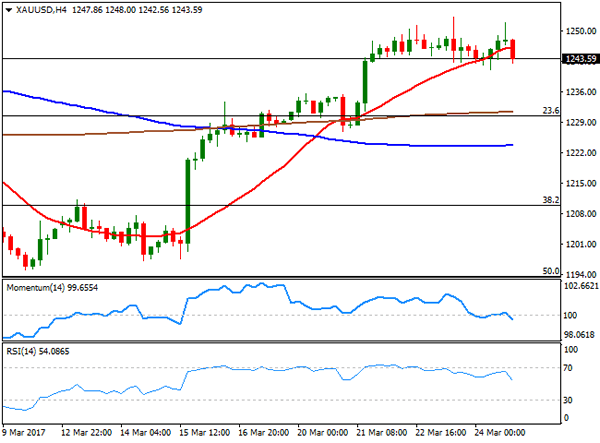
WTI CRUDE
Crude oil prices closed the week with losses, with West Texas Intermediate crude futures settling at $48.13 a barrel, having flirted with the 47.00 threshold earlier in the week, the lowest since the OPEC announced its output cut deal. There were no major news in the oil market this past week, although this Sunday, five representatives of OPEC and non-OPEC countries that signed the output agreement—Kuwait, Algeria, Venezuela, Russia and Oman—meet in Kuwait to review the current level of compliance, and any headline coming from the meeting will likely affect oil prices. The daily chart shows that the price remained well below its moving averages, with the 20 DMA maintaining a strong bearish slope around 49.85, whilst technical indicators have bounced from oversold territory, but remain well below their mid-lines, maintaining the risk towards the downside. In the 4 hours chart, the price ended a few cents above a bearish 20 SMA, while technical indicators have corrected higher, but lost upward momentum within neutral territory, in line with the longer term outlook.
Support levels: 47.80 47.00 46.40
Resistance levels: 48.30 48.80 49.50
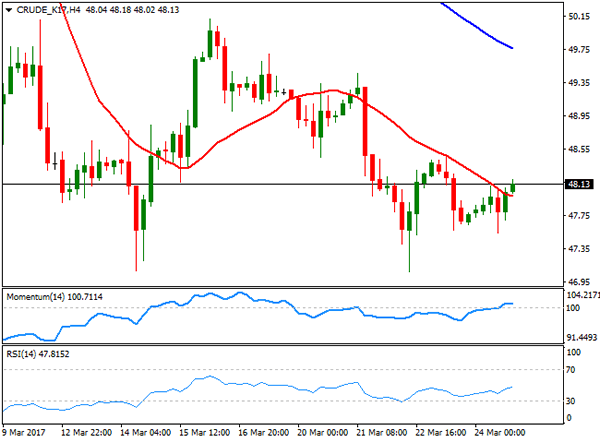
DJIA
Wall Street closed mixed on Friday, after the ruling Republican party pulled out the healthcare bill amid lack of support. The Dow Jones Industrial Average settled at 20,596.72, down 0.29% or 59 points, while the S&P lost 2 points, to 2,343.98. The Nasdaq Composite managed to advance 11 points, and closed at 5,828.74. Indexes plummeted after the news, but bounced off the daily lows, as the healthcare sector turned positive after the news, and following Trump’s words that the government will move on towards the tax reform. Within the Dow, Nike led the advance adding 1.79%, followed by American Express that closed 0.46% higher. Goldman Sachs was the worst performer, down 1.5%, followed by El du Pont that shed 1.19%. The technical picture for the index is bearish according to the daily chart, as the index extended its decline further below a now bearish 20 DMA, whilst technical indicators have turned south within bearish territory, with the RSI indicator heading south at 39 and anticipating some further declines. In the 4 hours chart, the index met selling interest on approaches to a bearish 20 SMA, currently at 20,659, while the Momentum indicator heads modestly lower below its 100 level, whilst the RSI indicator consolidates around 35, maintaining the risk towards the downside.
Support levels: 20,578 20,528 20,467
Resistance levels: 20,648 20,707 20,742
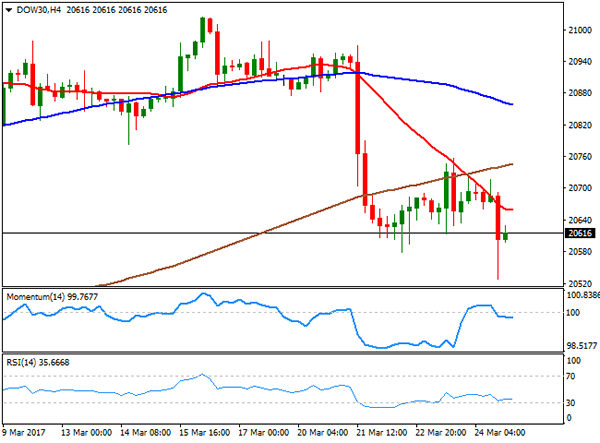
FTSE 100
The FTSE 100 closed at 7,336.82 last Friday, down on the day 0,05% or roughly 4 points, to its worst week since mid January. Investors were cautious ahead of the US Congress decision on the healthcare bill. Smiths Group led the way higher, adding 2.89% after the company said that its pretax profit more than doubled I the six months to January 31st. Smurfit Kappa led decliners, ending the day 3.16% lower, followed by Ashtead Group that shed 2.43%. Mining-related equities closed mixed, with Randgold Resources making it to the top 10 list, closing 0.92% higher. The daily chart for the index shows that it remained capped by a modestly bullish 20 DMA for a third consecutive day, but closed not far below, whilst technical indicators remain flat within neutral territory, not enough to confirm further declines ahead. In the 4 hours chart, the 20 SMA heads lower above the current level, around 7,357, providing an immediate resistance. In the same chart the Momentum indicator heads higher within negative territory, but the RSI indicator remains flat around 42, reflecting the ongoing range bound trading.
Support levels: 7,301 7,262 7,239
Resistance levels: 7,357 7,392 7,447
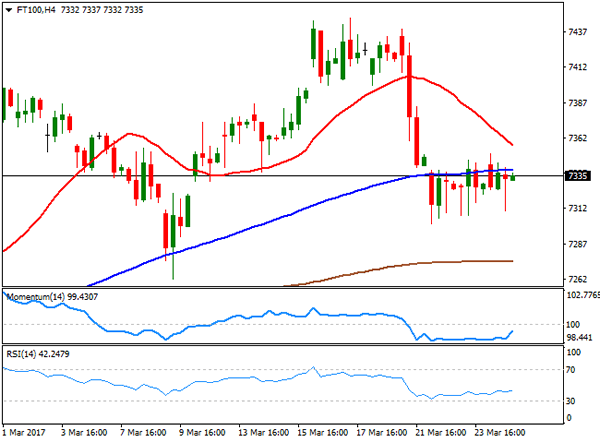
DAX
European equities closed generally lower on Friday, although the German DAX managed to add 24 points or 0.20% and settled at 12,064.27. Trading was choppy in the region, as investors were waiting for the US Congressional decision over the healthcare bill. Supporting the German benchmark was the release of March preliminary PMIs, as according to Markit, the private sector in the country grew as its strongest pace in over five years, with the Composite PMI estimated at 57.0 from 56.8 in February. Infineon Technologies was the top performer, adding 8.97%, after the company said that it increased the outlook for revenues for the full 2017 fiscal year. RWE AG followed, closing up 1.75%. Deutsche Bank on the other hand led decliners, ending the day 1.27% lower. The daily chart for the index shows that it managed to advance further above a bullish 20 SMA, whilst technical indicators turned north after a failed attempt to break lower, supporting additional gains ahead. Shorter term, and according to the 4 hours chart, the risk is also towards the upside, as the benchmark settled above all of its moving averages, whilst technical indicators present modest upward slopes after entering bullish territory.
Support levels: 12,028 11,976 11,928
Resistance levels: 12,091 12,139 12,177
